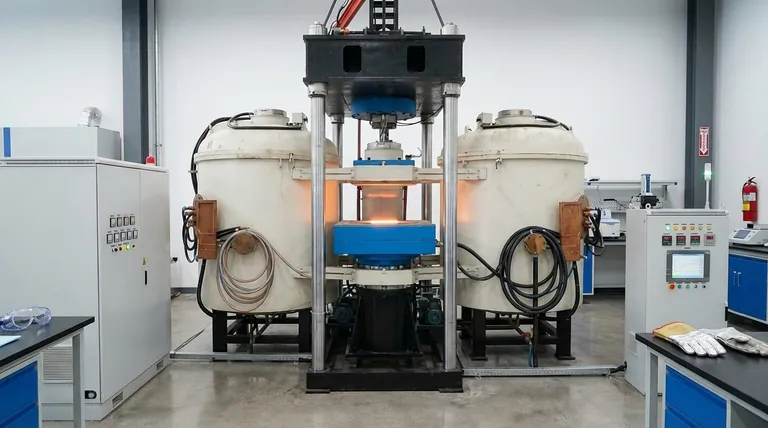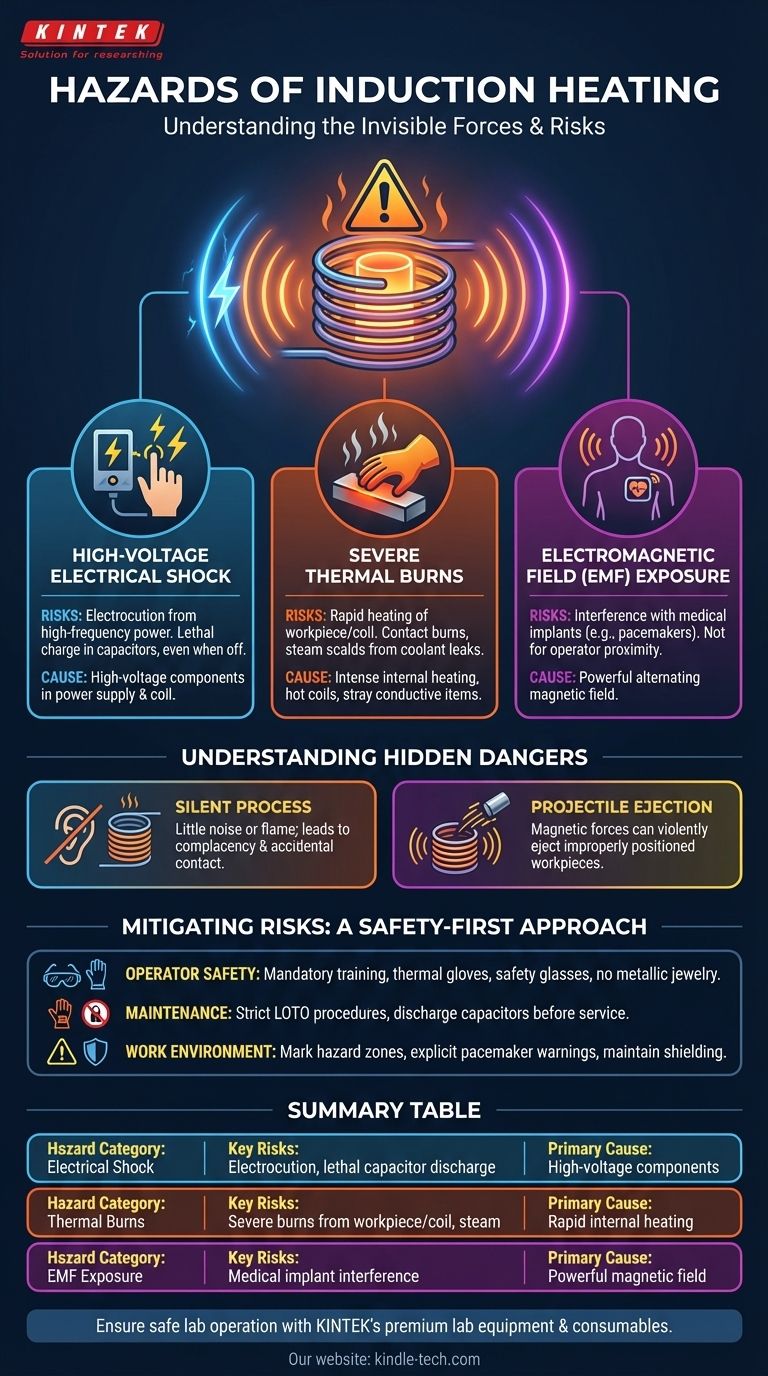While induction heating is rightly praised for its speed and cleanliness, it presents three primary categories of hazards: severe electrical shock from high-voltage components, serious thermal burns from rapidly heated materials, and potential health risks from strong electromagnetic fields. Understanding these dangers is the first step toward implementing a safe and effective process.
The core hazards of induction heating are often less intuitive than those of open-flame methods. They stem from the invisible forces of high-voltage electricity and powerful magnetic fields, which can cause harm without the warning signs of noise or visible flame.

The Primary Hazard Categories
To operate an induction system safely, you must understand where the dangers originate. The risks can be broken down into three distinct physical principles at play.
High-Voltage Electrical Shock
The power supply for an induction heater converts standard plant voltage into a high-frequency, high-current output to drive the induction coil. This creates a significant risk of electrocution.
Contact with the internal components of the power supply or the induction coil itself can be lethal. A critical point of awareness is that capacitors within the power supply can store a deadly charge long after the main power has been disconnected.
Severe Thermal Burns
Induction heating generates heat inside the workpiece, leading to extremely rapid temperature increases. This presents several vectors for severe burns.
The workpiece itself can become red-hot in seconds, often without any visible flame or warning. Accidental contact will cause an immediate and deep burn.
The induction coil also becomes hot due to its own electrical resistance (I²R losses) and proximity to the heated part. Coils are typically water-cooled, and a leak in a coolant line can create a secondary scald hazard from steam.
Finally, any stray conductive materials, such as rings, watches, or metallic tools, brought into the magnetic field will also heat up instantly, posing a serious risk of contact burns to the operator.
Electromagnetic Field (EMF) Exposure
The process works by creating a powerful, alternating magnetic field. While generally safe for operators at a distance, this field is a critical hazard for certain individuals.
The primary and most acute risk is to personnel with active medical implants, such as pacemakers or insulin pumps. The strong magnetic field can interfere with or disable these life-sustaining devices.
All facilities using induction heating must have clear signage and protocols to prevent individuals with such implants from entering areas where the field strength is significant.
Understanding the Trade-offs: Hidden Dangers
Unlike conventional heating, the hazards of induction are often silent and invisible, which requires a different level of situational awareness.
The "Silent" Nature of the Process
A gas furnace has a visible flame and a distinct roar. An induction heater, by contrast, can bring a piece of steel to its melting point with little more than a quiet hum. This lack of sensory feedback can lead to complacency and accidental contact.
Risk of Projectile Ejection
The powerful magnetic forces can, in some cases, violently eject a small or improperly positioned workpiece from the coil. This turns the heated part into a dangerous projectile, creating a risk of both impact injury and burns.
Auxiliary System Failures
The safety of the system relies on more than just the power supply and coil. A failure in the water-cooling system is a common point of failure that can cause the coil to overheat and rupture, potentially creating an arc flash or steam explosion.
Mitigating Risks: A Safety-First Approach
Effectively managing these hazards requires specific procedures tailored to the unique nature of induction heating.
- If your primary focus is operator safety: Implement mandatory training on all hazards, enforce the use of thermal gloves and safety glasses, and establish a strict policy against wearing metallic jewelry near the equipment.
- If your primary focus is equipment maintenance: Always enforce strict Lockout/Tagout (LOTO) procedures, paying special attention to discharging stored energy from capacitors before any service begins.
- If your primary focus is managing the work environment: Clearly mark hazard zones around the coil, post explicit warnings for pacemaker wearers, and ensure the equipment's shielding is properly maintained to contain the magnetic field.
By respecting the invisible forces at play, you can leverage the power of induction heating both effectively and safely.
Summary Table:
| Hazard Category | Key Risks | Primary Cause |
|---|---|---|
| Electrical Shock | Electrocution, lethal capacitor discharge | High-voltage components in power supply/coil |
| Thermal Burns | Severe burns from hot workpiece/coil, steam from coolant leaks | Rapid internal heating of materials |
| EMF Exposure | Interference with medical implants (pacemakers) | Powerful alternating magnetic field |
Ensure your lab operates safely with the right equipment. The hazards of induction heating demand reliable, well-designed systems. KINTEK specializes in premium lab equipment and consumables, serving all your laboratory needs. Our experts can help you select the safest induction heating solutions for your application. Contact us today to discuss how we can enhance your lab's safety and efficiency!
Visual Guide

Related Products
- 600T Vacuum Induction Hot Press Furnace for Heat Treat and Sintering
- CVD Diamond for Thermal Management Applications
- Non Consumable Vacuum Arc Induction Melting Furnace
- RF PECVD System Radio Frequency Plasma-Enhanced Chemical Vapor Deposition RF PECVD
- Chemical Vapor Deposition CVD Equipment System Chamber Slide PECVD Tube Furnace with Liquid Gasifier PECVD Machine
People Also Ask
- What products are made by hot pressing? Achieve Maximum Density and Performance for Your Components
- What is the effect of increasing the pressure during sintering? Achieve Maximum Density and Superior Performance
- Is brazing or welding cheaper? A Detailed Cost Analysis for Your Project
- What does bond strength depend on in braze welding? Master the 3 Keys to a Strong Joint
- What is the advantage by using hot press forming? Achieve Stronger, More Complex Parts



















